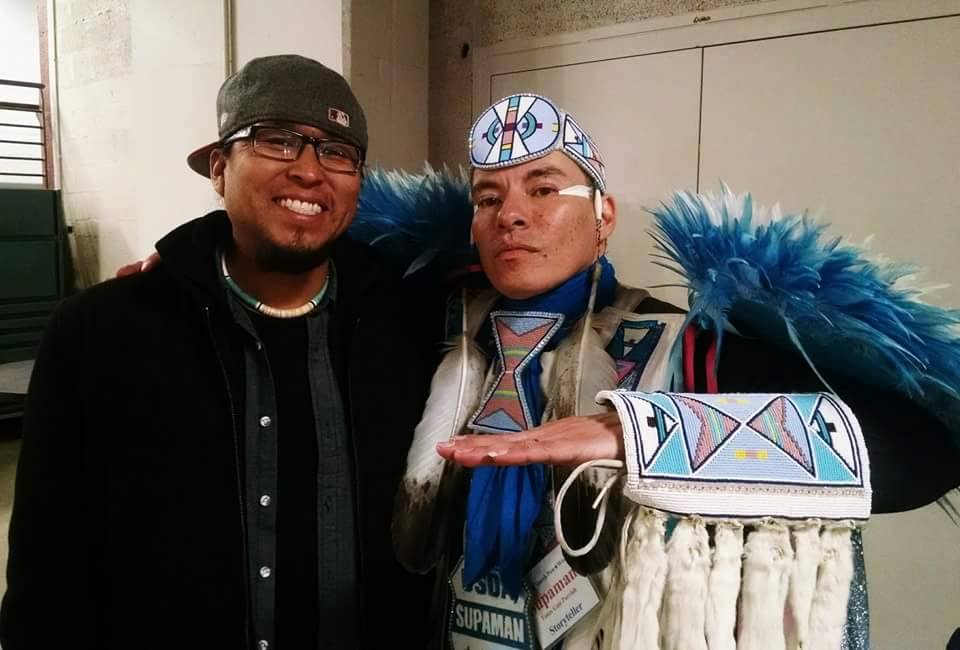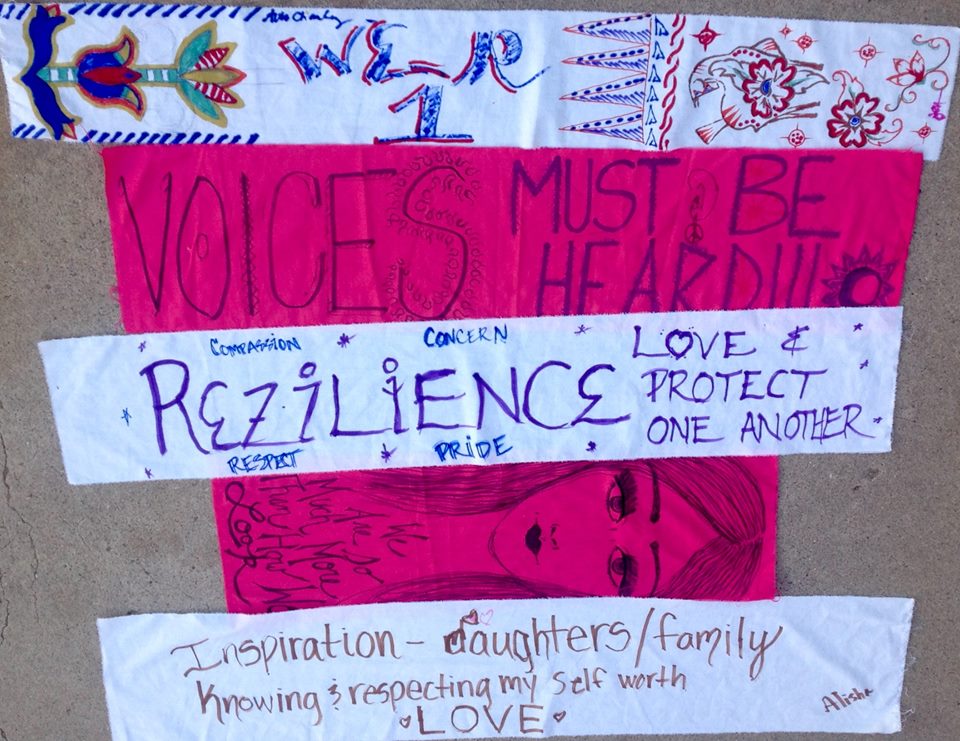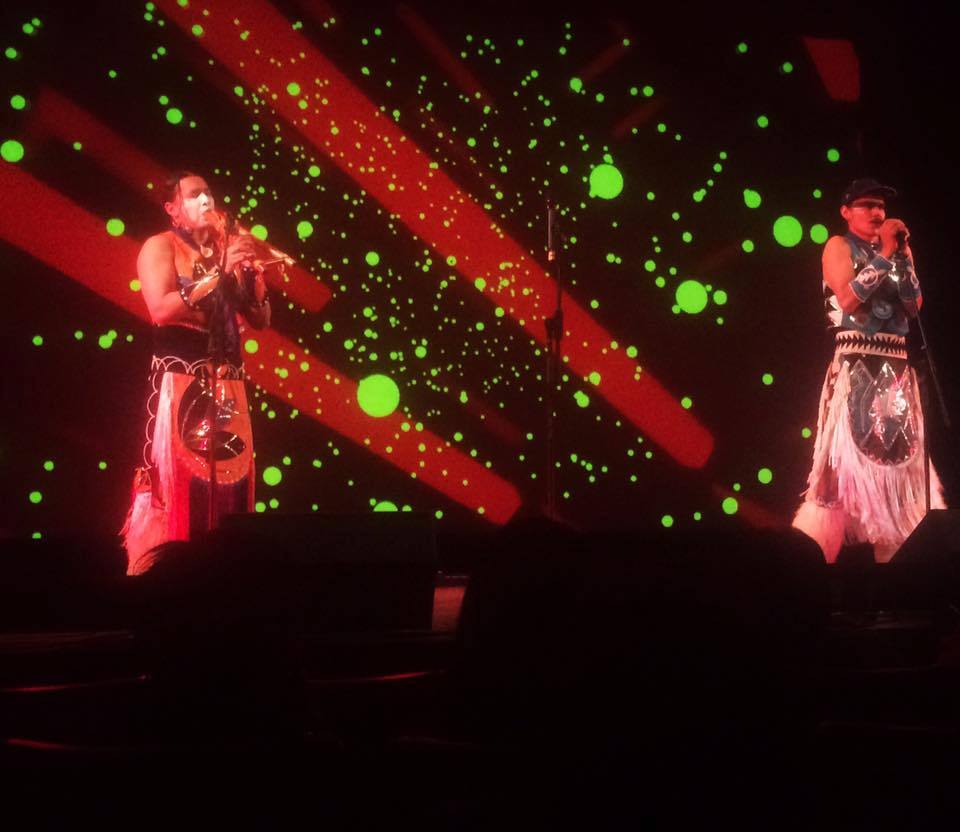Warren Montoya has created something that Rezonates
Santa Ana Pueblo/Santa Clara Pueblo artist Warren Montoya knows a little something about resilience. Though he has been an artist since childhood, drawn to the art of comic books and surrealism – he calls Salvador Dali “one of my boys” – his career took a shift after earning a bachelors degree in fine arts and working as a graphic designer. Instead, he began working in “therapeutic adventure programming,” which, he jokes, is a fancy way of saying that he worked for a nonprofit taking groups out into the wilderness to teach resilience skills.
He put his art aside for several years while doing this, but all of that resilience training came in handy in a completely unexpected way when he broke his leg in 2011 and was immobile for several months. At that time he got back into his art practice, finishing pieces and getting them into art shows and markets in order to make a living while he was laid up.
“It started working out,” he says. “[Breaking my leg] was a blessing in disguise. That’s how I really got back into my own art.”
Montoya started Rezonate Art in 2013 as an online store where other Native American artists could sell their artwork, jewelry, and apparel. He was good at marketing his own work and he liked doing it, and he wanted to help other people do the same.
Rezonate – a playful yet proud way of claiming the slang term “rez,” referring to a reservation controlled by a Native American tribe – functioned as a kind of collective, supporting and promoting Native American artists at festivals, fairs, and other events. Montoya focused on this for a year and a half, but, he says, in the back of his mind he always had an idea for doing something “really big,” something that would really help and serve his community.

Montoya is from the Santa Clara Pueblo of northern New Mexico and now lives in the Santa Ana Pueblo. His experience as a native person living in New Mexico’s pueblos informs his work as an artist and community organizer.
“I’ve always had a connection to my indigenous heritage and native community,” he says. “Along with wanting to promote the arts and creative industries, I’ve just been really active in promoting indigenous people’s stories to break down cultural stereotypes. My company does that to educate people through art about native people.”
Though he says he is more of an entrepreneur than an artist these days, Rezonate has grown to a point that allows Montoya to do some of the “bigger” community worker he had always envisioned doing. While the company’s mission is still to help native artists get their work out to a larger audience and make their work more visible while at the same time educating the public and dispelling cultural myths and stereotypes about native peoples, Rezonate now works with larger organizations on everything from consultations to commissions, idea generating and mapping to implementation and maintenance, for larger-scale visual art projects like murals.
“Originally I was [helping other artists] in how they operate so I could start my own art program for youth,” he explains. “Nonprofits are [always looking for funds], so that model is what I started exploring. I knew I needed some kind of funding mechanism to help this out instead of stepping into the old, outdated model, and that’s why I created the business – so it could be a funding mechanism to support community arts.”
However, he says, it soon consumed his life, and in 2015 he thought that there has to be a better way.
“We wanted to do community arts projects, so I thought, ‘Why are we taking the long way around? Why aren’t we just doing that?'”
In 2015 Rezonate switched its focus from retail sales to producing public art on a contract basis. Since then the company has completed six large projects, mostly murals (Montoya’s specialty), in collaboration with other artists brought in for the projects.

This business model – a for-profit business with a community-driven mission – has enabled Montoya to expand out into nonprofit work, as was always his intention. When Rezonate was still focused on retail sales, they would also produce events that promoted the apparel and other merchandise they had. There would be live art events, fashion slows, and music performances, and even after Rezonate changed its mission they continued producing events, which grew into something new entirely: the Rezilience Indigenous Arts Experience.
The first Rezilience event was held in the spring of 2016. This arts festival brought together 21 organizations and individual organizers from New Mexico together for an event that featured live 2D art, workshops, poetry, music, film, and an art market. Montoya pulled the whole thing together in just over four months. The event drew a little under 1,000 people, with visitors from all over North America.
“It was quite a feat! If I knew what I was getting into I probably wouldn’t have done it,” he laughs.
After a successful first year, Rezilience is now an annual event, with the second festival coming up April 29-30. It is also becoming its own nonprofit organization, with a fiscal sponsor and a host of organizational partners ranging from schools and community organizations to larger nonprofits and arts organizations, as well as local businesses.
“The way it is structured, Rezilience is the shell, the platform – we’re the plate for all those flavors, the beans and the enchiladas. We’re the facilitator of the space to invite these organizations to shine, to show their programs and show their communities,” Montoya explains. “This way we’ll have a lot more crossover of diverse attendees. These organizations all have their own networks and constituents. They’re inviting their people and we all get to get together and learn and actually interact. There are activities, workshops – things people are practicing and can participate in.”

While Rezilience features indigenous programming and participants, the goal is to engage many different people from all backgrounds, races, and ages, encouraging diversity. It is an all-ages event, and children aged seven and under get in free.
This year, Montoya says rather than focusing strictly on arts, Rezilience will intentionally involve elements of arts education, wellness, and technology. This will also extend out to additional programming throughout the year.
“Really what we’re talking about is building communities with what we already have – that’s resilience,” he states. “This model is utilizing the traditional indigenous way of building communities. It really is about bringing all the people together and building this thing together, and everybody benefiting from it as well.”
The ticketed event, held at the National Hispanic Cultural Center in Albuquerque, is just $10, and each of the partner organizations receives a portion of the proceeds to support their programs with the remainder going to support future Rezilience programming.
“We’re making a contribution back to the community,” says Montoya. “It’s multi-dimensional, so it’s doing a lot more than just being a one-off event.”

(1) How do you like to collaborate?
I like to really get to know people and work with diverse groups. I am pretty selective when it comes to collaborating though because sometimes the nature of some collaboration can be one-sided. I really like developing cohesive relationships with other that are mutually beneficial. I like to collaborate on art, community, wellness, events, youth, business, projects or initiatives.
(2) How do you a start a project?
I have an idea book. I recommend to anyone who has a lot of ideas, especially random ideas, to get one! This is where many of my projects have begun. From there I figure out what the project is really trying to accomplish then figure out what time it will take. Of course, this is all driven by inspiration to see the project through.
(3) How do you talk about your value?
I talk about my values in many ways but the most profound ways are from a cultural perspective or human one. I think that many of us strive or want the same things for our lives, happiness, fulfillment, gratitude, respect, positivity, encouragement. So really its about being in the moment and using aspects of our lives to learn more about what these mean.
(4) How do you define/feel success?
Self-success is relative so for me it revolves around simply not participating in destructive behavior, owning my actions, having conviction about the things that I believe in or love and having a positive impact on this planet as much as I can.
(5) How do you fund your work?
With hard work, haha. But really with everything from contracts, commissions, volunteered support, to crowd funding campaigns, donations, grants, etc. I really try hard to utilize resources as investments toward generating some sort of impact or return. This helps to keep the work going an helps it build on itself.
